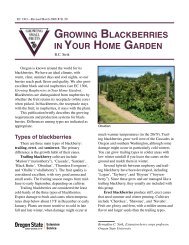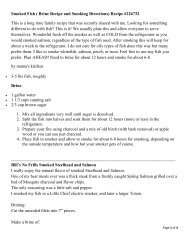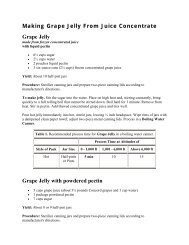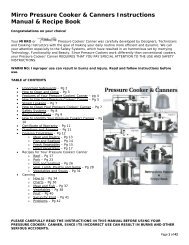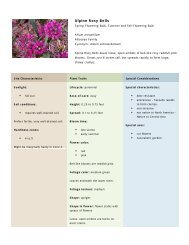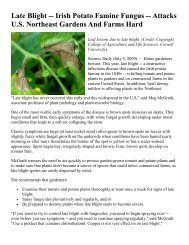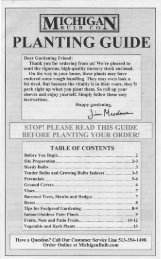Strawberry and Raspberry Pest Management in Wisconsin
Strawberry and Raspberry Pest Management in Wisconsin
Strawberry and Raspberry Pest Management in Wisconsin
Create successful ePaper yourself
Turn your PDF publications into a flip-book with our unique Google optimized e-Paper software.
Table 9. Spray schedule for raspberries (cont<strong>in</strong>ued)<br />
When to spray Problem Treatment a Formulation Rate/acre Remarks<br />
PREBLOOM (cont<strong>in</strong>ued) Insects<br />
EARLY BLOOM Diseases<br />
raspberry sawfly *diaz<strong>in</strong>on 50WP 2.0 lb<br />
4EC 2.0 pt<br />
malathion c 50WP 2.0–4.0 lb<br />
8F, 8EC 1.0–2.0 qt<br />
sp<strong>in</strong>etoram WG 3.0-6.0 oz<br />
sp<strong>in</strong>osad Entrust 1.25–2.0 oz<br />
Sp<strong>in</strong>Tor 4.0–6.0 fl oz<br />
2SC<br />
(5–10% of blossoms open) gray mold Captevate 3.5 lb<br />
fenhexamid 50WDG 1.5 lb<br />
iprodione 50WP 1.0–2.0 lb<br />
4F 1.0–2.0 pt<br />
Prist<strong>in</strong>e 18.5–23.0 oz<br />
anthracnose,<br />
cane blight,<br />
spur blight<br />
FULL BLOOM Diseases<br />
AFTER BLOOM Diseases<br />
azoxystrob<strong>in</strong> F 6.0–15.5 fl oz<br />
copper hydroxide 35% DF 1.5–3.0 lb<br />
copper sulfate 53% WP 4.0 lb<br />
Prist<strong>in</strong>e 18.5–23.0 oz<br />
propiconazole EC 6.0 fl oz<br />
pyraclostrob<strong>in</strong> EG 14.0 oz<br />
powdery mildew azoxystrob<strong>in</strong> F 6.0–15.5 fl oz<br />
myclobutanil 40W 1.25–2.5 oz<br />
propiconazole EC 6.0 fl oz<br />
Prist<strong>in</strong>e 18.5–23.0 oz<br />
sulfur 81–92% WP see remarks<br />
Insects Do not apply <strong>in</strong>secticide dur<strong>in</strong>g bloom.<br />
gray mold <strong>and</strong> other<br />
fruit rots<br />
Any of the fungicides listed for gray mold<br />
under Early Bloom.<br />
Insects Do not apply <strong>in</strong>secticide dur<strong>in</strong>g bloom.<br />
anthracnose<br />
cane blight<br />
spur blight<br />
fruit rots<br />
powdery mildew<br />
Any of the fungicides listed for these<br />
diseases under Early Bloom.<br />
Any of the fungicides listed for<br />
gray mold under Early Bloom.<br />
Any of the fungicides listed for powdery<br />
mildew under Early Bloom.<br />
rust diseases azoxystrob<strong>in</strong> F 6.0–15.5 fl oz<br />
myclobutanil 40W 1.25–2.5 oz<br />
propiconazole EC 6.0 fl oz<br />
Insects<br />
aphids<br />
leafhoppers<br />
thrips<br />
acetamiprid 30 SG 2.5-5.3 oz<br />
70 WP 1.0-2.3 oz<br />
*diaz<strong>in</strong>on 50WP 2.0 lb<br />
4EC 2.0 pt<br />
malathion c 50WP 2.0–4.0 lb<br />
8F, 8EC 1.0–2.0 qt<br />
leafrollers Any of the <strong>in</strong>secticides listed for<br />
leafrollers under Prebloom.<br />
mites *bifenthr<strong>in</strong> WSB 16 oz<br />
2EC 6.4 fl oz<br />
To avoid select<strong>in</strong>g resistant stra<strong>in</strong>s of fungi, use these<br />
products judiciously (see “Fungicide Resistance”).<br />
Captevate has a 72-hour REI.<br />
Do not apply sulfur when temperatures exceed 85–<br />
90°F. Caution: sulfur may <strong>in</strong>jure some cultivars.<br />
Cover sprays should be applied at approximately<br />
14-day <strong>in</strong>tervals up to harvest as needed <strong>and</strong> are<br />
most important dur<strong>in</strong>g cool, wet seasons.<br />
Do not exceed four applications of either<br />
pyraclostrob<strong>in</strong> or iprodione per year.<br />
Captevate has a 72-hour REI.<br />
Aphids can also be controlled with *esfenvalerate at<br />
the rate of 4.8-9.6 fl oz/a Asana XL.<br />
See remarks for leafrollers under Prebloom.<br />
*Bifenthr<strong>in</strong> has a 3-day PHI.<br />
37




